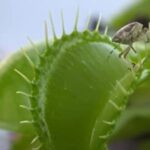As an Amazon Associate, this site earns commissions from qualifying purchases. For more details, click here.
Venus flytraps behave a lot like predatory animals so that we tend to think of them in those terms. So it is only natural for people to ask if Venus flytraps have genders, or if they have babies like mammals do. While these plants have traits similar to animals, in many ways they are very different.
Venus flytraps do not have genders. Each plant has a pistil (female part) and stamen (male part), and it can reproduce sexually or asexually. Venus flytraps can also be propagated through leaf pulling and tissue culture.
Venus Flytrap Sexual Reproduction
Venus flytraps produce nectar to attract insects. When a bug lands on the stamen (located at the end of the plant filament), it removes the pollen and drops it into the pistil (in the middle of the Venus flytrap).
You can do this yourself by dabbing a cotton ball into the stamen and rubbing that into the pistil. The seeds will be fertilized and fall into the soil. It will grow and replace the dead flowers. We recommend Rio Hamza Trading Soil Mix as it can speed up growth of these plants.
You can achieve the same effect by taking two Venus flytrap flowers and rubbing them against each other. But this is something you should only do if the plant is indoors.
If your Venus flytraps are outdoors, insects will take care of pollination. While these plants can feed on spiders, flies and small roaches, they do not harm the insects that pollinate them.
You can also self pollinate a Venus flytrap. However you will get higher seed germination rates through cross pollination. Cross pollination involves fertilizing a pistil from one plant with the pollen from another plant.
How effective this can be for Venus flytraps depends on the variant. Whatever method you use, the flowers are going to die eventually. However you should see several black seeds amongst the dead flowers.
Sow the seeds right away with peat moss and silica sand. Keep the soil moist and the temperature between 85-70F.
If the seeds get 12 hours of sunlight daily, they should germinate in 2-4 weeks. Venus flytraps take five years to mature, so do not be disappointed if you only see a small plant after a year or so.
Can You Multiply Venus Flytraps Asexually?
Aside from sexual reproduction, these plants can reproduce asexually. There are two methods, leaf pulling and a second rosette growth.
Asexual reproduction is also known as vegetative reproduction. One of the advantages of asexual reproduction is the product will be an exact match. So if you like a particular flytrap, you can use any of the following techniques to reproduce its characteristics.
Another benefit of asexual reproduction is the plant grows faster. Venus flytraps take 3-5 years to grow from seed to maturity. With asexual methods it will only take 1-2 years.
That is a huge difference for beginners. What many may not realize is that cultivating Venus flytraps take time and effort. Aside from proper soil and water, you also have to make sure your Venus flytrap gets enough nourishment.
Venus Flytrap Leaf Pulling
As the name suggests, you can split a Venus flytrap into two by pulling a leaf. This should only be done with mature Venus flytraps that have seven or more leaves.
A Venus flytrap with seven leaves or more means it reproduces from its rhizome and can be split into two. This is how you do it.
- Remove the Venus flytrap from its container.
- Hold one of the outer leaves and pull down until it is separated from the rhizome. You can repeat the process with other leaves on the rhizome and produce new Venus flytraps.
- Put the parts you removed from the rhizome in a new container or pot. Add 2 parts sphagnum moss and 1 part coarse sand. This is the kind of environment that Venus flytraps prefer, low in nutrients.
- Moisten the mixture with distilled, reverse osmosis or ionized water. Make sure the mix is moist but do not drench it. We recommend LIFEWTR Premium as it is chemical free water.
- Press your thumb in to the mixture, about an inch deep. Put the leaf with the mixture and around the leaf. Water the plant.
After some time, the leaf will wither and a Venus flytrap will take its place. When this will happen depends on how healthy the leaf is and how much sunlight it receives.
If the leaf has roots it will grow faster, but even without it a Venus flytrap will emerge. However it will take more time.
Do not fertilize the soil because the plant does not need it. The plant gets its nutritional requirements from insects. You can also give it freeze dried mealworms when it has matured.
Keep the plant 1/4 inch deep in water, which is how it grows in the wild. 12 hours of sunlight is ideal for Venus flytraps.
Tips for Leaf Pulling
- Give the leaf a good pull. Choose only a healthy leaf and is not inside the rhizome.
- Pull down and try to grab as much of the rhizome white area as possible.
- Use the same soil you do for your Venus flytrap. Never fertilize the soil.
- It will take several months before you see any leaves. This requires patience.
- Never pull leaves off a flowering Venus flytrap. This will result in an unhealthy plant and will probably die quickly.
If you decide to cut off the flower stalk, place its base on the soil. Chances are this will grow into a new plant. Just drop the flower stalk in the soil and it will grow. Wait until the stalk is 3 inches long before you cut it. Then plant it in the ground and nature will do the rest.
Reproduction Through Rosette Growth
Another way to propagate Venus flytraps is wait for another rosette growth. At some point, the plant will produce another growth point in its rosette.
You can tell there is a growth if several leaves are bunched together. The leaves also appear to form from several areas.
Once you have seen the growth, leave it there until repotting time in spring. When spring comes, check if the rosette has roots. If it has, separate it from the Venus flytrap and plant it in another container. Follow the steps given earlier to ensure the plant thrives.
If the rosette has not taken root, do not separate it yet. Wait until it has roots, otherwise it will not survive being repotted.
Venus Flytrap Reproduction Through Tissue Culture
Tissue culture propagation uses flower stalks, seeds or leaves to grow Venus flytraps. These are cultivated in petri dishes not soil, so it is only for those with advanced knowledge of these plants.
This is the fastest, most reliable method to produce several Venus flytraps. However you need special equipment and careful preparation to do it.
First the flytrap tissue has to be sterilized. It is put in a special container to remove all pathogens. There are many ways to do this, but the simplest is to use a mixture of bleach, alcohol and peroxide.
The tissue is then placed is a container rich in nutrients that will help a Venus flytrap grow. The tissue will remain here for 8 to 16 weeks or until a leaf has grown.
Once a leaf has emerged, it can be moved to a pot and planted in the manner described earlier. If you have the means and knowledge, this is the best way to reproduce Venus flytraps quickly.
If you are new to Venus flytraps, there is no need to start thinking about this yet. Just use the other methods given here and your plant will be fine. Or you can just grow the plant outdoors and let the insects take care of pollination. What is important is that the Venus flytrap receives the best care possible.
Conclusion
Venus flytraps are among the most fascinating plants in the world because of their behavior. Now that we know how Venus flytraps can reproduce in different ways, they become even more interesting.

My fascination with carnivorous plants began many, many years ago with Venus Fly Traps. Now I am more than happy to impart what I know with other enthusiasts and those who are curious about meat eating plants.



